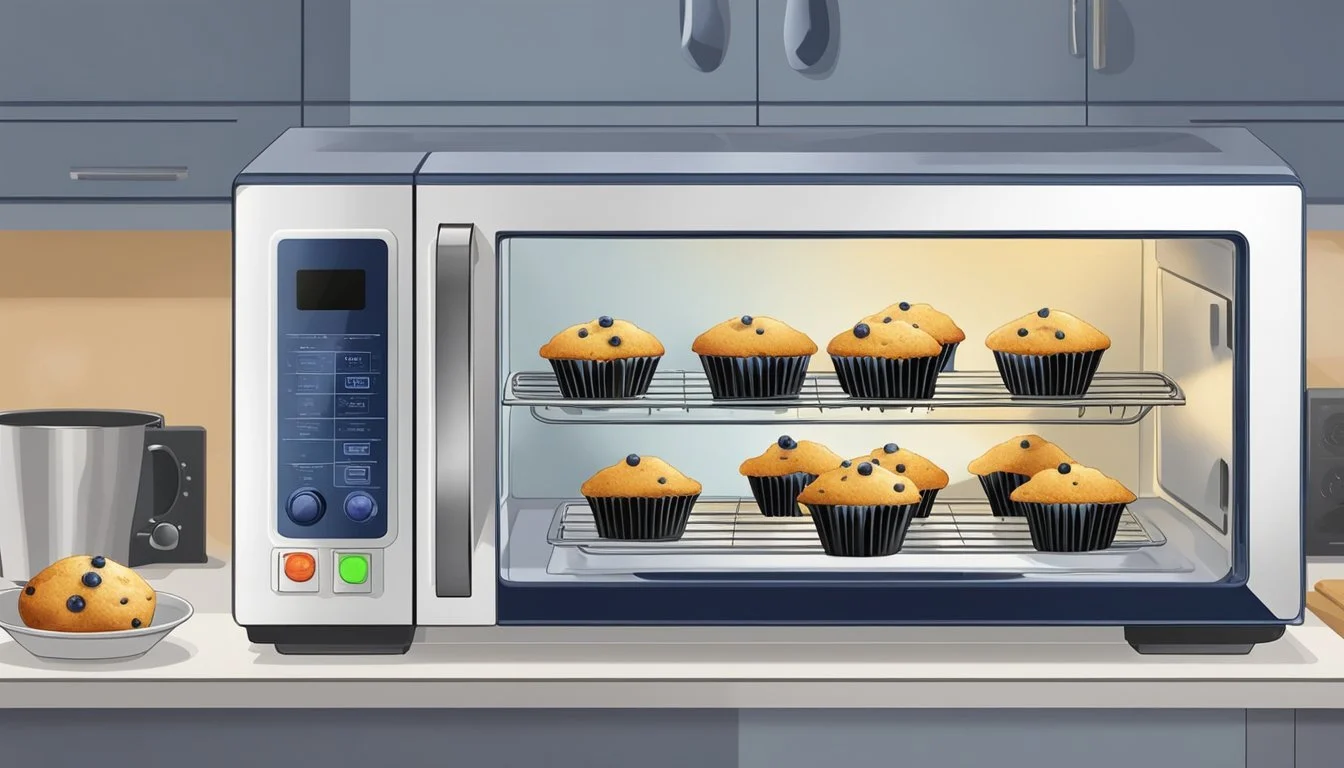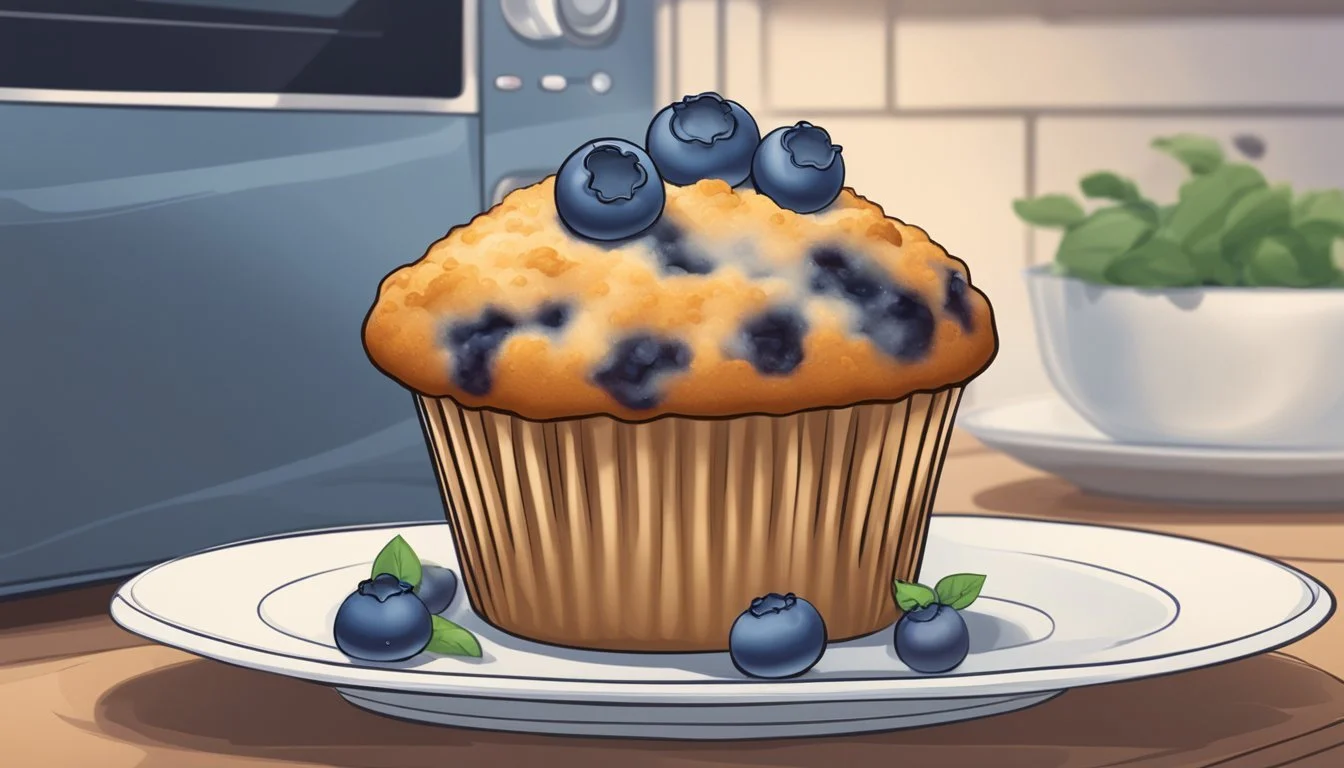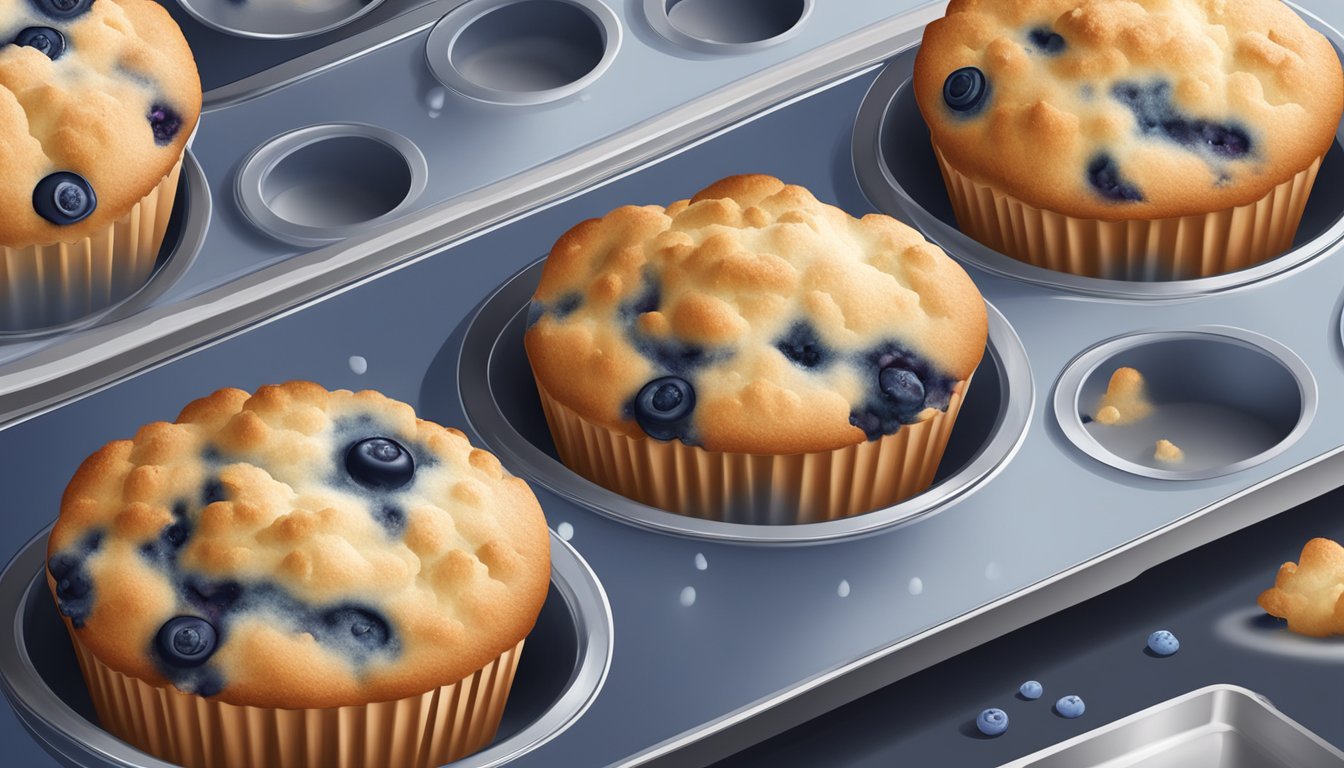Best Way to Reheat Blueberry Muffins
Ensuring Freshness and Moistness Restoration
Reheating blueberry muffins to their just-baked glory is a simple process that preserves the moistness and delicious taste of these beloved treats. When muffins are stored, they often lose the tender crumb and moist interior that make them so enjoyable. However, with the right technique, one can revive the freshness and ensure that every bite is as satisfying as it was the day the muffins were first baked.
To maintain the delectable moistness of blueberry muffins, it is crucial to choose a reheating method that won't dry them out. Using a conventional oven or a toaster oven is a preferred method, as these allow for even heat distribution without direct contact with intense heat sources. Covered with foil and possibly lightly sprinkled with water if they appear stale, muffins can regain their moisture while being warmed through.
While speed is of the essence for many, microwaves are often a last resort for reheating baked goods due to their tendency to unevenly heat and potentially toughen the texture. However, when used carefully with a damp paper towel, microwaves can provide a quick alternative for those in a hurry. Keeping the muffins moist and delicious requires careful attention regardless of the reheating method, ensuring that these little delights can be enjoyed as if they were fresh from the oven.
Understanding Muffin Freshness
The freshness of muffins is vital to maintain their desirable moist and fluffy texture. This section explores crucial aspects that contribute to the longevity of muffin freshness.
Factors Affecting Moistness
Several factors influence the moistness of muffins through the days following their baking. These include:
Storage Conditions: Muffins kept in airtight containers retain moisture better than those left exposed to air.
Ingredients Used: A muffin recipe with higher fat or sugar content tends to remain moist longer due to their hygroscopic nature.
Environmental Humidity: In humid environments, muffins can absorb moisture from the air, conversely, in dry climates, they may dry out faster.
Anatomy of a Muffin
Understanding the components that make up a muffin can shed light on why they stale:
Crumb: The interior, when fresh, is characterized by a soft, fluffy, and moist texture.
Crust: The exterior provides a slight contrast in texture, which can lose its delicate quality over time.
Signs of Staling
Muffins exhibit clear indicators when they start to stale:
Texture Change: Initially moist and fluffy, a muffin becomes dense and chewy as it stales.
Flavor Loss: The degradation of flavor compounds leads to less pronounced taste.
Visual Cues: A once shiny and tender top may appear dull and harden as it loses moisture.
Storing Blueberry Muffins
Proper storage of blueberry muffins maximizes freshness and prepares them for satisfying reheating. Each storage method is adapted to the length of time the muffins will be stored.
Room Temperature Storage
For blueberry muffins that will be enjoyed within a couple of days, room temperature storage is suitable. They should be allowed to cool completely in the muffin tin to avoid condensation and then stored in an airtight container. To maximize moisture retention, it's advisable to line the bottom of the container with a paper towel and cover them gently with another paper towel to absorb any excess moisture.
Freezing and Thawing
Beyond a few days, blueberry muffins are best preserved in the freezer, which can keep them fresh during and beyond blueberry season. Muffins should be placed in a single layer inside a freezer bag, removing as much air as possible to prevent freezer burn. To thaw, transfer them to the refrigerator overnight or leave them at room temperature for a few hours; this gradual process helps maintain their quality.
Preventing Dryness on Storage
Preserving the moistness of blueberry muffins while in storage is crucial for their enjoyment later on. Wrapping them in aluminum foil can help maintain their original texture. When using containers, ensure they are sealed tight to protect against dry air. A diligent approach to storage keeps muffins delectably moist and ready for a perfect reheating.
Reheating Techniques
Choosing the right reheating method is crucial to restoring the moistness and flavor of blueberry muffins. It’s important to select a technique that will gently warm the muffins without drying them out or creating a soggy texture.
Microwave Method
To reheat muffins in the microwave, one should place them on a microwave-safe plate and cover them with a damp paper towel. Heat on high for about 30 seconds, then check for warmth and moisture. If necessary, heat in additional 15-second increments until the desired temperature is reached.
Oven Reheating
Oven reheating is ideal for achieving an evenly warm interior and slightly crisp exterior. Preheat the oven to 350 degrees Fahrenheit with an oven thermometer to ensure accuracy. Place muffins on a baking sheet and heat for approximately 10 minutes. If muffins are stale, lightly sprinkle water over them before heating.
Stovetop Renewal
For the stovetop renewal, one needs to preheat a non-stick skillet over medium heat. Place muffins in the skillet and cover with a lid to trap in heat and moisture. Warm for about a minute on each side, carefully monitoring to prevent burning.
Toaster Oven Warming
Using a toaster oven can provide a quick and efficient method of warming. Heat the muffins at 300 degrees Fahrenheit for around five minutes. This method works similarly to conventional ovens but is better for smaller batches and can prevent overheating.
Air Fryer Approach
An air fryer can reheat muffins effectively due to its rapid air circulation. Set the air fryer to 300 degrees Fahrenheit and heat the muffins for 2-3 minutes. One should check the muffins halfway through to ensure they don't overheat or dry out.
Baking the Perfect Muffins
Creating perfect blueberry muffins requires a careful selection of ingredients and adherence to precise baking techniques. Each component plays a pivotal role in the muffin's flavor and texture while the process ensures the ideal rise and moistness.
Choosing Ingredients
Blueberry muffins are best crafted with fresh, high-quality ingredients. The foundation starts with all-purpose flour, which offers structure. Use baking powder and baking soda in the right ratios—typically 1 to 1.5 teaspoons of baking powder and 1/4 teaspoon of baking soda for every cup of flour—as these leavening agents are crucial for a light, airy texture. Incorporate eggs to combine the ingredients and incorporate air. Sugar provides sweetness, while a pinch of salt enhances the overall flavor profile. Milk adds moisture, and a splash of vanilla extract introduces a hint of warm, aromatic flavor.
Dry Ingredients:
Flour: Essential for structure.
Baking Powder and Baking Soda: Ensures proper rise.
Sugar: Sweetness.
Salt: Flavor enhancement.
Wet Ingredients:
Eggs: Binding and aerating agent.
Milk: Adds moisture.
Vanilla Extract: Flavor complexity.
Muffins Baking Process
The process of baking muffins requires precision and attention to detail. Begin by preheating the oven, commonly to 400°F (204°C), providing the initial heat needed for the muffins to rise properly. Mix the dry ingredients in one bowl and the wet ingredients in another, combining them gently to avoid overmixing; this can result in tough muffins. When incorporating blueberries, coat them lightly in flour to prevent them from sinking to the bottom. Portion the batter evenly into a greased muffin tin and bake until a toothpick inserted into the center comes out clean, which can take about 20 to 25 minutes. They should be allowed to cool in the tin for a few minutes before being moved to a wire rack, preserving their tender crumb.
Enhancing Blueberry Muffin Recipes
Enriching blueberry muffins requires focusing on the nuances of flavor, texture, and nutrition. These modifications can transform a basic blueberry muffin recipe into an exemplary homemade treat suitable for breakfast or a snack.
Incorporating Flavor Variations
To diversify the taste of blueberry muffins, cooks can experiment with a medley of ingredients. Introducing citrus zest, such as lemon or orange, infuses a fresh brightness that complements the juicy blueberries. Alternating liquids in the muffin batter, such as replacing water with buttermilk, yogurt, or sour cream, also imparts a richer flavor profile and a tender crumb to the muffins.
Textural Additions
The texture of blueberry muffins can be enhanced by integrating elements that provide a pleasant contrast. For example:
Crunchy: A streusel topping or a sprinkling of coarse sugar before baking adds a satisfying crunch.
Moist: Substituting oil for butter in recipes yields a moister muffin, as oil retains more moisture during the baking process.
These textural contrasts make each bite more engaging and can elevate a simple recipe to a delightful food experience.
Nutritional Adjustments
Blueberry muffins can be nutritionally balanced by making conscientious ingredient swaps. Replacing all-purpose flour with whole wheat flour or oat flour boosts fiber content. To augment the protein level, one can add a scoop of protein powder to the muffin batter. For those monitoring their sugar intake, reducing the sugar and incorporating ripe banana muffins can offer natural sweetness alongside additional vitamins.
Recipe Customizations
Tailoring muffin recipes to personal preferences or dietary needs is straightforward. Here are some customizations:
Fruit Choices: Utilize a mix of fresh or frozen blueberries, or add raspberries for varied flavor.
Allergies: For a dairy-free version, substitute buttermilk or yogurt with almond or coconut milk.
Portion Sizes: Adjust baking times to accommodate different muffin pan sizes, making everything from mini muffins for a quick snack to larger ones for an easy-to-make, satisfying breakfast.
Each alteration in the recipe allows for a unique twist on the classic blueberry muffin, turning it into a custom creation.
Advanced Muffin Making Tips
Mastering the craft of muffin making requires attention to detail and technique. From preventing the muffins from sticking to the pan to ensuring each muffin has a delectable, dome-shaped top, and maintaining their inherent moisture, each step is critical for achieving perfection.
Preventive Measures Against Sticking
One can never underestimate the importance of a well-prepared muffin pan when striving for non-stick results. Muffin liners are a baker's first defense, providing an easy release. Alternatively, a light coating of nonstick cooking spray can be applied directly to the pan. It’s vital to fill each cup evenly to prevent overflow, which creates sticking hazards after baking.
Achieving Dome-shaped Tops
For the coveted bakery-style, dome-shaped tops, one should fill muffin cups three-quarters full with batter. This ensures the muffins have enough room to rise without spilling over. Preheating the oven to a temperature slightly higher than the recipe suggests and then lowering it when the muffins are put in can also promote a rapid rise resulting in a fluffy, domed top.
Moisture Retention Techniques
A muffin's moisture is its soul. To retain this, the timing of the bake is key—overbaking is a surefire way to a dry muffin. Wrapping muffins in a paper towel after they've cooled for a few minutes can trap in moisture, keeping them tender for longer. When reheating, a quick stint in the oven covered with foil can revive a muffin's moisture, especially if a light sprinkle of water is added prior to heating.
Creative Serving Suggestions
After reheating blueberry muffins to their prime moistness, pairing them with complementary flavors or adding a decorative touch can elevate the experience. Here are specific ways to serve these treats that can impress guests or add a twist to a snack.
Pairing with Other Foods
Combining blueberry muffins with other food items can create harmonious pairings that satisfy different taste preferences.
For a Classic Breakfast: Serve warm blueberry muffins with a side of cinnamon rolls, allowing the spicy warmth to complement the muffin's fruity notes.
Dessert Pairing: Pair them with a slice of blueberry pie, balancing the textures of the flaky crust with the soft muffin.
Citrus Twist: Accompany with lemon poppy seed muffins for a contrasting citrusy flavor that cuts through the sweetness.
Chocolate Lovers: Alongside chocolate chip muffins, the varying flavors can cater to those who enjoy both fruity and chocolatey desserts.
Decorative Topping Ideas
Decorative toppings not only add visual appeal but can also introduce new textures and tastes to blueberry muffins.
Streusel Topping: Sprinkle a streusel topping made from brown sugar, butter, and flour for a sweet, crumbly texture.
Add Fresh Fruit: Top with extra blueberries for a burst of freshness and a more intense blueberry flavor.
Butter with a Twist: Spread salted butter or brown butter on a halved muffin to add a rich, savory note.
Aromatic Flavors: A drizzle of almond extract or vanilla infused glaze can introduce a warm, aromatic quality to the classic blueberry muffin.
For best results, use mixing bowls to combine toppings and a wire rack to let any glazes set without the muffins becoming soggy.
Muffin Troubleshooting
Ensuring the perfect consistency and flavor in muffins requires a keen eye for detail and an understanding of common pitfalls. This section addresses the most prevalent issues that can occur during the baking process.
Common Baking Mistakes
Muffins can suffer from a variety of baking mistakes, which in turn can affect their moistness:
Ingredient Measurements: Using too much flour can lead to dry muffins. They should incorporate all-purpose flour with precision, measuring by weight rather than volume when possible.
Mixing Technique: Overmixing the batter develops the gluten excessively, resulting in tough muffins. It's important to mix just until the dry and wet ingredients are combined.
Maintaining Consistency
Uniform Size: Using a muffin tin with even portions and filling each cup consistently ensures that all muffins bake uniformly.
Paper Liners: Employing paper liners can help absorb excess grease and make storing muffins easier, extending their freshness over a few days.
Avoiding Over-Baking
Correct Temperature: Baking muffins at the right temperature, typically 375-400°F, is crucial to prevent a burn on the crust.
Timing: One should check muffins several minutes before the recipe’s suggested baking time as oven temperatures can vary. They look for a golden-brown top and a toothpick inserted in the center coming out clean or with a few moist crumbs to determine doneness.
Muffins are freezer-friendly and can retain their quality for up to two months when stored properly. Before freezing, they can wrap individual muffins in plastic wrap or aluminum foil. Reheating them effectively also plays a key role in regaining their original moistness and soft texture.
Conclusion
The restoration of blueberry muffins to their peak moistness is achievable through careful reheating techniques. When employing these methods, attention to temperature and timing is imperative to avoid overbaking. The toaster oven, air fryer, and conventional oven stand out as the leading methods. In these appliances, one can control the heat distribution, ensuring the muffins are evenly warmed.
Toaster Oven: A brief period at medium heat can refresh the muffins without drying them out.
Air Fryer: A short burst at a low temperature offers a quick and even reheating solution.
Conventional Oven: Enclosed with foil to trap moisture, a low-temperature oven reinvigorates the muffins' freshness.
The microwave, while convenient, often falls short, possibly toughening the delicate crumb of the muffin. Should this method be necessary, a dampened paper towel aids in providing moisture.
For those who have crafted muffins following their own meticulous recipe, it is recommended to give the baked goods the respect they deserve by choosing a method that maintains their quality. It's best to avoid the stovetop for blueberry muffins, as direct heat can unevenly warm and potentially compromise the texture.
Reheating blueberry muffins is not merely about achieving warmth; it's about rekindling the baked good's inherent moisture and tender crumb. By adhering to these reheating guidelines, one can ensure the blueberry muffins remain as delightful as when they first emerged from the oven.









